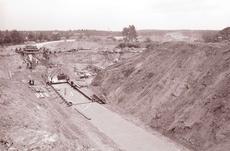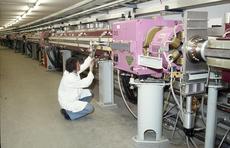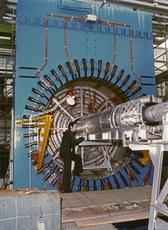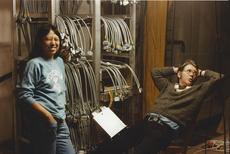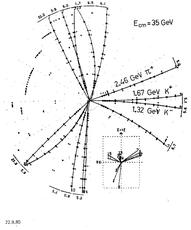URL: https://www.desy.de/news/backgrounders/40_years_of_gluon/index_eng.html
Breadcrumb Navigation
The discovery of the gluon – a research trip back to the 70s
The discovery of the gluon - a journey back in time to the 70s
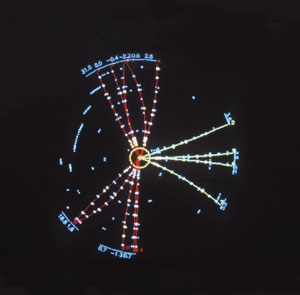
The year is 1979. Particle physics is still a young field and trying to emancipate itself from nuclear physics. While the so-called Standard Model of Particle Physics is gaining recognition and acceptance, it has so far been unable to establish itself unequivocally. The model suggests that all the matter in the universe is composed of just 12 elementary particles: six quarks and six leptons. These are thought to interact by means of four fundamental forces, three of which are described by the (current) Standard Model: the strong force, which acts on quarks, the weak force and the electromagnetic force – only the (very much weaker) force of gravity is ignored by the model.
Five of the six quarks that make up particles known as hadrons had by now been discovered by experiments, the most recent of these being the bottom or beauty quark in 1977. However, the forces were still causing particle physicists something of a headache: according to the Standard Model, also the forces were supposed to be mediated by particles – so-called exchange bosons. Until then, however, the only exchange particle that had been found was the photon. It is responsible for electromagnetic interactions, such as light, electrical or magnetic forces. By this time, more than 50 years had gone by since its discovery …
Great hopes were therefore pinned on two new, powerful particle accelerators. One, the Positron Electron Project PEP at the Stanford Linear Accelerator Center, SLAC, in California, was still under construction, while the other, the Positron-Electron Tandem Ring Accelerator, PETRA, at DESY, had recently gone into operation. The hope was that they would at last provide evidence that the other forces could also be explained in terms of the exchange of virtual particles.
While construction was still under way on the PEP in 1979, DESY’s accelerator team managed to store the first electron beam in PETRA by the middle of 1978. This meant the accelerator was ready to go to work more than a year earlier than originally planned, after a construction period of little more than two and a half years. That was the achievement of its excellent and extremely motivated construction team, but most of all of Gustav-Adolf Voss, the director of the project, who guided his resourceful project team with unconventional ideas and bold decisions. In order to win the race against the competing accelerator in the United States, for example, he awarded the contract to build the iron yokes for the deflecting magnets to a company that had until then produced refrigerators. It had no previous experience with building particle accelerators, but it was able to supply the necessary parts quickly and at a competitive cost. Legend has it that project meetings took place on Sundays to leave the weekdays free for working.
Overall, five international collaborations had been formed to build the particle detectors that were to record the collisions between the electrons and positrons. The detectors were called CELLO, JADE, MARK J, PLUTO and TASSO. Although DESY was involved in all these collaborations, it did not insist on adopting a particular role within the team, as was the custom at that time. Instead, the participating institutes elected a spokesperson for the collaboration, who represented the team externally and towards the host institute – a form of organisation that caught on and was later adopted throughout the field of particle physics. As PETRA only offered room for four such particle cameras, PLUTO, which had already been deployed in the accelerator DORIS, was only to collect data when PETRA first went into operation and to be replaced by whichever of the other four detectors was completed last.
The first particle beam having been stored by PETRA in July 1978, the first collisions between electrons and positrons were observed in September of the same year. Data-taking started in January 1979 by the detectors MARK J, PLUTO and TASSO. The fourth detector, JADE, had suffered damage during a trial run and was not expected to be able to collect data again before early summer in 1979.
To begin with, the accelerator was operated at low collision energies of around 13 gigaelectronvolts (GeV). This level was first increased to 17, and in the spring of 1979 to 27 GeV. Full of anticipation, the experimenters scanned the first data they had collected and were able to confirm some of the predictions made by the quark model. However, the search for the gluon was at the back of everyone’s minds right from the start. Indirect hints for the existence of these adhesive particles had already emerged in previous experiments; but so far no one had been able to furnish direct proof of them. Would the gluon reveal itself in the collision images of the PETRA experiments and, if so, in what form?
In their effort to detect gluons, the experimenters hoped that the strong nuclear force would display similarities to the electromagnetic force: just as electrons emit a photon, an electromagnetic exchange particle, when they are slowed down, a phenomenon known as bremsstrahlung, the scientists hypothesised that a quark might emit a gluon. Once created, this would have to decay into a ray of particles known as a jet. This hard gluon bremsstrahlung was to be triggered by an event inside a PETRA detector, in which the colliding particles formed two quarks, which themselves also decayed in the form of jets after emitting the gluon. Hence an electron-positron collision that gives rise to a gluon ought to be characterised by three clearly distinct jets of particles inside the detector. The laws of the conservation of energy and momentum meant that all three jets had to lie in the same plane. The hunt for this precise signature was now on.
The most optimistic gluon hunters were probably the team of the TASSO collaboration, which in addition to DESY included members from the German universities of Aachen, Bonn and Hamburg, Imperial College, Oxford University and the Rutherford Lab in the UK, the Weizmann Institute in Israel and the University of Wisconsin in the United States.
Sau Lan Wu and Georg Zobernik, from the University of Wisconsin, had written an extremely efficient program to analyse the collisions in which quarks were formed, and had also calculated that it ought to be possible to create gluons in PETRA by means of bremsstrahlung at collision energies above around 22 GeV. Finally, in June 1979, a few days before a conference in Bergen (Norway), the TASSO scientists identified the first event consisting of three distinctive jets in their data, as Event 13177 of Run 447. Freshly analysed, so to speak, Bjørn Wiik took it along to the “Neutrino 79” in Bergen on 18 June and placed it on the overhead projector as the last transparency of his presentation “First Results from PETRA”. It was to become the transparency with the greatest repercussions: the gluon had seen the light of (the scientific) day.
Two months later, at the Lepton Photon Conference Chicago, all four PETRA collaborations were able to present analysed results displaying the three-jet signature in a single plane. If there had been any doubt before then, whether the events presented might simply be statistical fluctuations, it was now clear once and for all: the gluon, the mediator of the strong interaction, had been discovered in the summer of 1979.
In 1995, the TASSO scientists Paul Söding, Bjørn Wiik, Günter Wolf and Sau Lan Wu were awarded the High Energy and Particle Physics Prize by the European Physical Society for this discovery. Together with the members of their collaboration and the other experiments – JADE, MARK J and PLUTO – they ensured that the three-jet event would forever remain linked to the PETRA collider.
Not only did many of the scientists involved go on to pursue impressive careers after the discovery, the PETRA accelerator itself has also continued to create quite a sensation to this day. Having spent 15 years living in the shadows of the electron-proton collider HERA, as its pre-accelerator, it is now living its third life as PETRA III, the world’s most brilliant X-ray source powered by a storage ring.
Meanwhile, the gluon remains a special star of particle physics: altogether, eight different such force carriers exist, only differing in their colour charge. Gluons can themselves emit gluons (in a sense, producing offspring), or else create particles together with other gluons – in other words, they are very gregarious. Scientists came up with quantum chromodynamics (QCD) as a set of rules to describe the strong nuclear force carried by gluons. This theory describes strong interactions with impressive accuracy, and to this day remains an important foundation for understanding particle physics as a whole.


